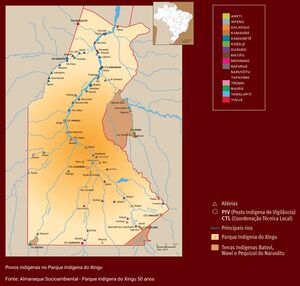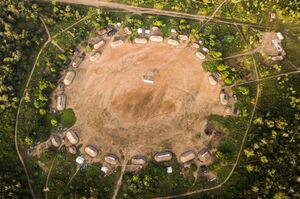Upper Xingu
The Upper Xingu is one of the research areas related to the Ekologos project, where Prof. Antonio Guerreiro and a team of anthropologists linked to the State University of Campinas carries out research on the transformation of traditional fishing technologies and other subjects.
The Upper Xingu is located at the Xingu Indigenous Territory, in Brazil. It is a multiethnic and multilingual complex, inhabited by 11 peoples speaking languages from three of the most important linguistic groups of Lowland South America (Arawak, Carib and Tupi) and an isolate (Trumai)[1][2]. It is located in a transition zone between the Brazilian Savannah, on the south, and the Amazonian rainforest, which extends to the north.
Our work is being carried out with the Kalapalo, one of the Carib-speaking peoples of the area, who have a population around 1000 persons living in 13 villages, most of them near the Culuene river and its tributaries[3]. Our Kalapalo closest partners live at the Aiha village, on the eastern area of the Culuene, where 238 people currently live.
We give a brief outline of our ongoing research projects below.
Documenting endangered traditional fishing technologies among the Kalapalo, Southern Amazon
This project arises from the community's perception of the effects of climate change on their rivers, lakes, and streams, and its impacts on their fishing methods.
The Kalapalo have chosen fishing as the pivot of their way of building relationships with nature and with other peoples. Their traditional fishing technologies are based on fish traps, dams and fishing nets made from different plant materials, comprise a vast ecological knowledge of the fish species of the Xingu River basin, and are intertwined with intangible knowledge such as songs and prayers. However, this system of material knowledge is severely threatened by environmental changes resulting both from human actions affecting the headwaters of their rivers and from climate change. With fishing and its traditional technologies threatened, not just a way of subsistence is at risk, but an entire way of life. Through audiovisual recordings, the production of maps and ethnographic descriptions, this project aims to document this threatened system of traditional fishing technologies, in all its dimensions, in order to contribute to its preservation for future generations.
The vitality of the fishing traps and smaller dams is seriously threatened by a combination of environmental changes. According to the Kalapalo, the lowering of the water levels of the Culuene River has been causing fish to seek refuge in lakes and streams. These, on their turn, have suffered in recent years from a notable increase in water temperature, leading fish to avoid shallower areas where traps could be installed. Without enough water for traps and dams to be installed, and with a decreasing amount of fish susceptible to them, the regular use of the e technologies is becoming progressively less viable, and it may soon disappear as a result of these environmental changes.
There is also a growing use of non-indigenous fishing gear and techniques, such as industrialized lines, hooks and nets, which compete with traditional technologies. This technological competition has already imposed a drastic impact on the use of traditional fishing nets, which are being largely replaced by nylon nets that dispense with the use of chants and prayers, which can also quickly disappear if the technology of traditional fishing nets is completely abandoned.
Finally, there is an imminent risk of a generational break in the chains of knowledge transmission. Today, only 3 adult men in the main Kalapalo village know how to make and use fishing traps; 2 adult men have the necessary knowledge to make dams and fishing nets; and only 1 knows the full repertoire of songs and prayers associated with the latter.
The literature on the Kalapalo and other peoples of the Upper Xingu highlights the centrality of fishing not only as a subsistence activity, but also as an ethical, cosmological and political choice. Their refusal to hunt manifests a greater refusal to behave aggressively towards others, whether human or not. The choice of fishing as a human activity par excellence is one of the cosmopolitical pivots of the pacifist multiethnic society that has formed between the Kalapalo and their neighbors over more than a thousand years of shared history. However, the region's fishing technologies have received very little attention, being mentioned only occasionally as an economic/ecological backdrop. In the Amazon in general, there is a long established tradition of research on hunting, pet keeping, relationships to domestic animals, and agriculture, that has become fundamental to understanding the ways Amerindian intertwine nature and society. Fishing, however, continues to occupy a marginal place, being usually seen as a "secondary" and "complementary" activity to hunting.
With this in mind, this project has the potential to offer a detailed and as yet unprecedented view of a system of material knowledge of an Amazonian society that has chosen fishing as a pivot of its way of existing in the world, and of relating to other societies and to nature. By incorporating into its scope the documentation of ecological knowledge associated with fishing and the Kalapalo's perception of the ecological transformations they experience, this project will also contribute to understanding the impacts of environmental changes on indigenous societies.
Our fieldwork is based on the combination of different methods:
- Community workshops, aimed at the transmission of knowledge from recognized knowledge holders to a larger indigenous audience;
- Interviews with knowledge holders, focusing on origin narratives, uses of different fishing technologies, ecological knowledge associated to fish and watercourses, and perceptions of environmental and technological transformations;
- Participatory mapping, in order to document the main Kalapalo fishing areas and ecological and immaterial knowledge related to them; and
- Participant observation, focusing on the documentation of the construction of dams and the making and use of traditional fishing nets.
Funding: Endangered Material Knowledge Programme/The British Museum
Go the project's website.
Hüge oto: an Amazonian musical ecology
The objective of this project is to document the oral literature and traditional ecological knowledge associated with the Hüge Oto ("Master of Arrows") ritual among the Kalapalo. This ritual is part of an intricate ceremonial system, consisting of about 15 types of intra- and inter-ethnic events that connect the ten peoples of the Upper Xingu in a unique multiethnic and multilingual ritual polity in the Amazonian context. This ritual is at serious risk of disappearing, as its last performance among the Kalapalo was in 1996, and currently only two men know its repertoire in its entirety.
Hüge Oto ("Master of Arrows") is a ritual that is both agonistic and playful, in which participants, sometimes divided between two groups of the same people, sometimes between hosts and guests from different peoples, sometimes between men and women, provoke and confront each other verbally and choreographically. The ritual can be performed by a single local group, but ideally should involve at least another people as guests, characterizing itself as a multiethnic event.
Indigenous anthropologist Mutua Mehinaku calls Hüge Oto “the Kalapalo speech theater"[4]. This ritual is centered on a confrontation between the Jaguar (Panthera onca) and the Tamanduá-Mirim (Tamandua tetradactyla), in which both debate which of the two protagonists would be the strongest. According to the stories, the dispute began with an ambush prepared by the Jaguar, who intended to attack and eat its antagonist, but the encounter unfolded into a verbal and performative competition that would make the victorious animal the greatest predator of the forest.
As in other Xinguano rituals, such confrontation is staged choreographically and accompanied by an extensive repertoire of songs. Hüge Oto lasts for a whole day and night, with singers taking turns continuously and alternating between sets of musical suites belonging either to the Jaguar or the Tamanduá-Mirim. Each suite includes songs on animals that are prey or have important ecological relationships with the protagonists. These songs, which mix elements of Carib and Arawak languages, along with their choreographies, elaborate a debate between the protagonists about their eating habits, bodily capacities, individual behaviors, and relationships with other animals. Thus, this repertoire also constitutes a complex verbal-choreographic reflection on the ecological relationships among the species involved in the ritual. Documenting the oral literature and traditional ecological knowledge associated with Hüge Oto will not only allow for its preservation for future generations, but will also help to clarify the connections between Kalapalo verbal-musical arts and their environment.
Funding: Firebird Foundation
Research team
Antonio Guerreiro, Associate Professor, Department of Anthropology, Institute of Philosophy and Human Sciences, State University of Campinas
Marina Pereira Novo, Associate Researcher, Research Centre on Indigenous Ethnology, Institute of Philosophy and Human Sciences, State University of Campinas
Tauana Kalapalo, independente indigenous film-maker
Ugise Kalapalo, MPhil student at the Post-Graduation Programme in Social Anthropology, State University of Campinas
Veronia Monachini de Carvalho, PhD candidate at the Post-Graduation Programme in Social Anthropology, State University of Campinas
Research publications
- ^ Andrello, Geraldo; Guerreiro, Antonio; Hugh-Jones, Stephen (2015). "Space-time transformations in the upper Xingu and upper Rio Negro". Sociologia & Antropologia. 5: 699–724.
- ^ Franchetto, Bruna (2011). "Evidências linguísticas para o entendimento de uma sociedade multilíngue: O Alto Xingu". In Franchetto, Bruna (ed.). Alto Xingu, uma sociedade multilíngue (in português) (1st ed.). Rio de Janeiro: Museu do Índio - Funai. pp. 3–38. ISBN 978-85-85986-34-6.
- ^ Guerreiro, Antonio (2024). "Images of movement: land, kinship, and history in the Upper Xingu". Etnográfica. 28: 75–98. doi:10.4000/etnografica.15139.
- ^ Mehinaku, Mutua (2010). Tetsualü: pluralismo de línguas e pessoas no Alto Xingu. Rio de Janeiro.

